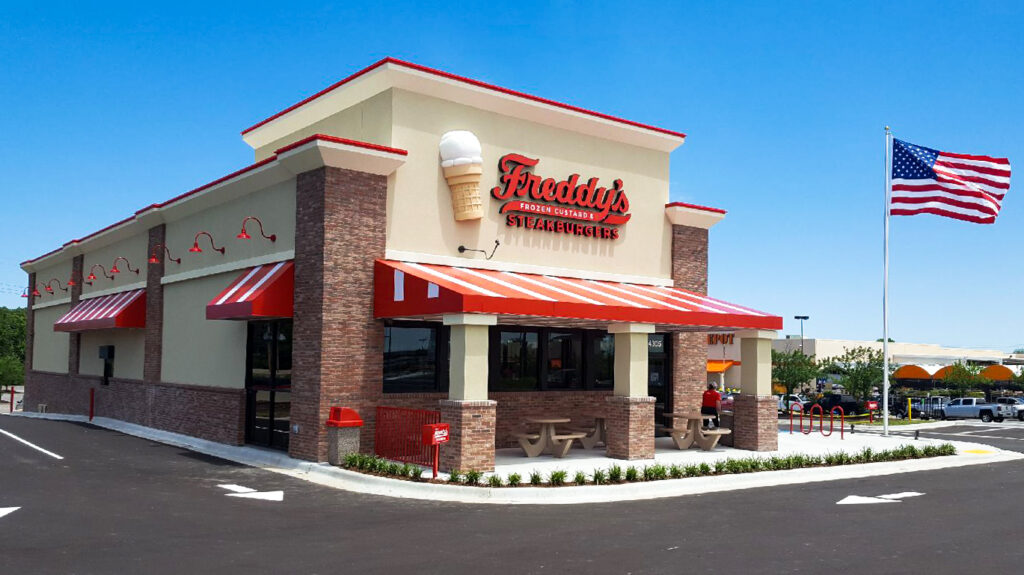A fast food restaurant and a fast-casual restaurant share many similarities. Both concepts offer faster and less expensive dining options than fine dining restaurants. Both offer multiple ordering choices (in-restaurant, drive-thru, online), and there is also usually a loyalty program. However, that’s where the similarities end.
Differences Matter in Restaurant Franchising
While fast food (i.e. McDonald’s) and fast-casual (i.e. Freddy’s Frozen Custard & Steakburgers) have some shared characteristics, their differences weigh heavily on the value of the franchise investment. There are three key distinctions to consider with a fast-casual vs. fast food restaurant comparison:
- The focus of each concept
- The menu commitment
- The investment ROI
Fast Food vs. Fast-Casual: The Concept Focus
Fast food is focused on getting customers in and out quickly, which is why drive-thrus are a significant portion of the business. The target audience is the time-stressed customer with only minutes to dedicate to getting a meal. The fast food restaurant is modeled around the fastest way to serve customers.
Fast-casual is focused on giving customers efficient service while also providing an elevated food experience. The quality of food is what you would expect from a sit-down restaurant, which is attractive to those customers who prefer a heightened experience. There is a commitment to quickly-prepared food for take-out customers who want a quality meal at the speed of a fast food restaurant.
Fast Food vs. Fast-Casual: The Menu
The fast food menu is based on production time. The menu has similar choices that can be prepared in the same way, thereby maintaining the commitment to getting as many people through the line as possible. To make this happen, there are fewer customization options.
In the fast-casual restaurant, customized menu choices are highlighted. There is also a higher quality of food as this concept uses fresh ingredients and incorporates greater menu variations. The food is prepared in a made-to-order experience.
Fast Food vs. Fast-Casual: The Financial Strategy
The fast food restaurant is based on volume orders. While they sometimes have a lower price point than fast-casual, they have to sell more to obtain growth-driven revenues. The fast-casual restaurant has a higher price point due to fresher and healthier ingredients and more opportunities for meal options that appeal to a customer’s individual preferences. Less volume is needed to achieve the revenue goals with a higher-paying clientele.
The fast-casual option caters to more a greater audience of customers, which also makes it more flexible in challenging economic conditions.
Evaluating Fast-Casual and Fast Food Franchises
The fast food restaurant has limited clientele; you have to make your money by volume. It also means your competition is other fast food restaurants that are after the same customer base with the same low-price offers. That can be a challenging business.
A Restaurant News article on why investors love fast-casual models listed these reasons why restaurants are moving toward the fast-casual model:
- Flexibility. Fast-casual optimizes food, labor, and rent costs. Wider menu offerings meet changing consumer tastes more quickly. Better ingredients allow for healthier options at competitive prices.
- Labor benefits. Counter and limited service reduce the need for front-of-house staff, an average of 30% of restaurant costs.
- Multiple dayparts. Fast-casual can span several daypart segments to capture sales, which leverages existing overhead efficiently.
- Revenue streams. With catering or third-party delivery, fast-casual is more readily adapted to off-premise sales.
- Financial benefits. Fast-casual is less expensive to open and has better payback periods, often of less than three years.
- Solid sales. Higher sales with increased profit margins create a foundation to grow more quickly.
- Economic conditions. Customers with less spending power historically trade down into fast-casual rather than not eating out at all.
Freddy’s is a Fast-Casual Favorite
At Freddy’s, we like to say there’s a meal for everyone. Whether you’re coming for lunch, a midday meal, dinner, or a late dessert, Freddy’s is a fast-casual franchise to suit everyone. When you can cater to a larger audience of customers, your financial foundation is wider from which to build and grow. We want franchisees to grow with our brand.
Freddy’s is a family-focused business. Consider these facts:
- Freddy’s franchisees have an AUV of $1,897,647*
- Fast-casual restaurants are positioned to grow by $55.4 billion (2022-2027) and record an 11.56% CAGR
- In 2021, same-store growth in the fast-casual segment outpaced all other food service categories: family dining, casual dining, quick service, and upscale casual dining
Choose Freddy’s as your restaurant investment. Complete our franchise information request form so we can start the conversation.
*Based on our most recent franchise disclosure document (FDD). See FDD for full details.
